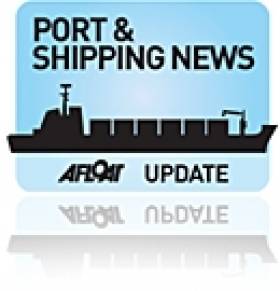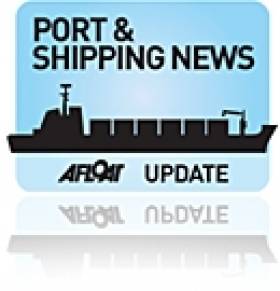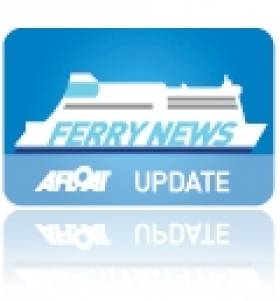Displaying items by tag: Irish Ports Conference
Ports & Shipping Review: ICG Half Yearly Report, Foyle Port Shipping Increase, UK & Irish Port Conferences and more…
#ShippingReview - Over the last fortnight Jehan Ashmore has reported from the shipping scene where Irish Continental Group (ICG) released half-yearly financial report.
Londonderry Port and Harbour Commissioners reported an increase in shipping through the port by 27% over the past year leading to before tax profits of over £1.2m.
Dublin based CMI - Communications Management Institute received a 50% increase in applications on a new Diploma in Ports & Shipping Diploma.
The British Ports Association annual conference offers all the latest policy, practice and technology in ports and harbours throughout the UK and takes place on 9-10 October in Grimsby.
On this side of the Irish Sea the Irish Ports Association conference is on 27 September and held in Dublin. The host of this year's conference is the Dublin Port Company.
Irish Ports Conference to Be Hosted by Capital Port
#PortsConference - The 2013 The Irish Ports Association Conference is to be hosted by Dublin Port Company and is to take place on 27 September in the Gibson Hotel in Dublin.
This year saw the launching of the new National Ports Policy, the conclusion by the Irish Competition Authority of a review of the ports sector and the publication by the EU Commission of a proposed ports Regulation. All of these create challenges for Irish ports whose efficiency and capacity is crucial to support international trade in goods.
The core themes of the IPA conference are ports policy, practice and planning. An elite panel of national and international speakers will not only examine recent policy developments but also to present examples from around the world (UK, Denmark, Greece and Chile) as to how ports elsewhere have adapted and responded to changing regulatory environments. For further information of the conference visit: ipadublin2013.com
Rosslare Europort to Host Irish Ports Conference
This year's Irish Ports Conference is to be hosted by Rosslare Europort on behalf of the Irish Port Association (IPA) and is to take place in Wexford on 30th September.
The event is the only one of its kind in Ireland this year where senior representatives from short-sea users, carriers, ports, logistics providers and the whole range of service providers meet to debate the topical issues of the day.
In addition the full-day conference provides those to network and explore further business opportunities and will culminate with the IPA's conference banquet.
The south-eastern ferry-port is to host delegates in the Ferrycarrig Hotel, just outside Wexford. For further information on booking and a (PDF) programme of the day visit the Rosslare Europort website by clicking HERE
Big Plans for Rosslare Europort
Ambitious plans to introduce load-on load-off (Lo-Lo) facilities at Rosslare Europort have been announced, according to a report in yesterday's Wexford People.
However, to facilitate all these developments, Mr Lynch said they will need the reclamation of up to 20 hectares of additional land and the deepening of part, or all, of the port from the current 7.2m to 9m and perhaps, eventually, 11m.
Mr Lynch said these developments would be facilitated, and accelerated, by of a port centric logistics zone (a grouping of activities dealing with freight transportation) on lands beside the south-eastern port.
Mr Breen said he recognises the 'fundamental and strategic importance of Rosslare Europort to the economic development of the county'.
The county manager said he will recommend that 'appropriate policies, objectives and development management standards are included in the draft plan to facilitate the development of the port', subject to the appropriate technical and environmental assessments.
As part of his submission, Mr Lynch also requested that the '1902 Lighthouse' at the port, which is recognised on the National Inventory of Architectural Services, not be included on the Record of Protected Structures.
Mr Breen said he would give further consideration as to whether it would be appropriate to de-list the lighthouse in advance of the draft plan.
Next month the port will host the annual Irish Ports Conference in the Ferrycarrig Hotel, Wexford on Friday 30 September.
- Rosslare Europort
- Ports and Shipping News
- Irish Rail
- Iarnrod Eireann
- Ferry news
- Rosslare Harbour
- Irish Ports Conference
- Irish Ports Association
- Ferrycarrig Hotel
- Railfreight
- Port Development
- National Inventory of Architectural Services
- Record of Protected Structures
- Irish Lighthouses
- Lighthouses of Ireland news
Wexford to Host Irish Ports Conference 2011
The Irish Ports Conference 2011 is set for Friday 30 September in Wexford.
The theme of this year's one-day conference is 'Navigating a Sea of Change: Delivering Jobs Through Trade'.
Rosslare Europort will be hosting the event at the Ferrycarrig Hotel in Wexford Town.
Further information and booking details will follow shortly.


































































